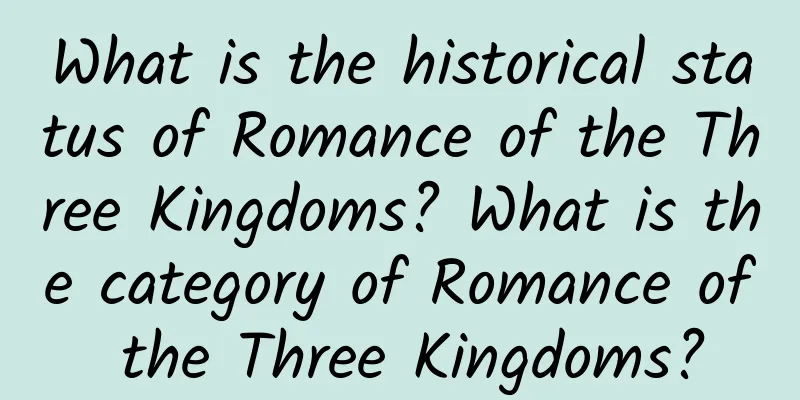What is the historical status of Romance of the Three Kingdoms? What is the category of Romance of the Three Kingdoms?

|
The Romance of the Three Kingdoms uses characters as carriers to vividly interpret the basic spirit of Chinese traditional culture, namely, benevolence, righteousness, courtesy, wisdom, trustworthiness, courage and other core elements of the value system of Chinese traditional culture. So, what is the historical status of the Romance of the Three Kingdoms? What is the category of the Romance of the Three Kingdoms? Let's take a look at the introduction of the Encyclopedia Knowledge Network to answer these questions! Contents of this article 1. The historical status of Romance of the Three Kingdoms 2. What is the category of Romance of the Three Kingdoms? 3. The meaning of Romance of the Three Kingdoms 1The Historical Status of Romance of the Three Kingdoms1. The Romance of the Three Kingdoms, with a scale of 750,000 words, uses a relatively mature novel language to create more than 400 characters, describes the course of history over nearly a hundred years, and creates a new genre of novel; 2. The Romance of the Three Kingdoms was introduced to Korea in the third year of the reign of Emperor Longqing of the Ming Dynasty. In the eighth year of the reign of Emperor Chongzhen of the Ming Dynasty, a Ming edition of the Chronicles of the Three Kingdoms was collected by Oxford University in the United Kingdom. 3. Since the Japanese monk Hunan Wenshan compiled and published the Japanese version of "Popular Records of the Three Kingdoms" in the 28th year of the reign of Emperor Kangxi, many countries such as Korea, Japan, Indonesia, Vietnam, Thailand, Britain, France, Russia, etc. have translated the novel into their own languages, and published many research papers and monographs, which made valuable discussions and high evaluations on the novel "Romance of the Three Kingdoms". 2What is the category of Romance of the Three Kingdoms?The Romance of the Three Kingdoms is classified as the first long historical novel in chapter form in China. The Romance of the Three Kingdoms is one of the four great classical Chinese novels. Its full name is Romance of the Three Kingdoms. The author is Luo Guanzhong, a famous novelist in the late Yuan Dynasty and early Ming Dynasty. After the Romance of the Three Kingdoms was completed, there were many versions such as the Jiajing Renwu version. In the late Ming Dynasty and early Qing Dynasty, Mao Zonggang rectified the chapter titles, revised the text, and changed the poems and essays of Romance of the Three Kingdoms. Romance of the Three Kingdoms describes the historical events of nearly a hundred years from the end of the Eastern Han Dynasty to the beginning of the Western Jin Dynasty. It mainly describes wars, tells the story of the wars among the heroes in the late Eastern Han Dynasty and the political and military struggles between Wei, Shu and Wu. In the end, Sima Yan unified the Three Kingdoms and established the Jin Dynasty. It reflects the transformation of various social struggles and contradictions in the Three Kingdoms era, summarizes the great historical changes of this era, and creates a group of powerful heroes of the Three Kingdoms. The book can be roughly divided into five parts: the Yellow Turban Rebellion, Dong Zhuo's Rebellion, the Warring States Period, the Three Kingdoms, and the Three Kingdoms' Return to the Jin Dynasty. On the vast historical stage, magnificent war scenes were staged. The author Luo Guanzhong integrated the Thirty-Six Strategies of War into the text, which not only contains plots but also military strategies. 3The meaning of Romance of the Three Kingdoms1. The Romance of the Three Kingdoms describes the historical events of nearly 100 years from the end of the Eastern Han Dynasty to the beginning of the Western Jin Dynasty. The book reflects the political and military struggles of the Three Kingdoms period, the penetration and transformation of various social contradictions in the Three Kingdoms period, summarizes the great historical changes of this era, and creates a group of heroic figures. 2. In his understanding of the history of the Three Kingdoms, the author showed a clear tendency to support Liu Bei and oppose Cao Cao. He took Liu Bei's group as the center of his description, praised the main figures of Liu Bei's group, and strongly exposed and criticized Cao Cao. Today, we should have a dialectical understanding of the author's tendency to support Liu Bei and oppose Cao Cao. Respecting Liu and opposing Cao Cao is the main tendency of folk legends, which implied the people's hope for the revival of the Han nationality in Luo Guanzhong's time. |
>>: What is alfalfa? The therapeutic value of alfalfa
Recommend
I got pregnant 20 days after IUD removal.
The contraceptive ring is a contraceptive medical...
What are the maintenance methods for women in spring?
We all know that many women love beauty very much...
Can I eat pumpkin vines when I'm pregnant?
Pregnancy is a very special time in a mother'...
Can I have a baby if I have liver disease?
Having a child is a lifelong experience for every...
Is uterine posterior wall fibroids serious?
Uterine posterior wall fibroids are actually a re...
How to quickly replenish milk when milk is drying up due to anger
Mothers should pay attention to their emotions, e...
Treatment of fibrocystic breast cancer
For the disease of fibrocystic breast hyperplasia...
Can I have a baby while taking Entecavir?
According to clinical medical statistics, long-te...
Treatment for acne on the face during early pregnancy
Acne on the face in the early stages of pregnancy...
What to do if you vomit after taking birth control pills
Contraceptive pills are drugs used to help people...
Can I take birth control pills after having sex 15 days after a medical abortion?
Medical abortion is a method of abortion that man...
Doctors urgently remind you that crayfish cannot be eaten like this!
Expert of this article: Zhang Zheng, PhD in Nutri...
Why do some recovered patients test positive again? Should we worry about the sequelae of COVID-19?
Source: Xinhua News Agency If you have questions ...
Can I eat zucchini during menstruation?
We also call zucchini white melon or horned melon...
Chest pain = breast cancer? Learn about 7 possible causes of breast pain
Do you panic when your breast hurts? Don’t rush t...









